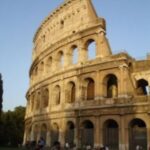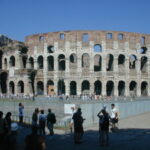One of the distinguishing characteristics about the Romans was their practical and utilitarian nature. Whereas the Greeks are acknowledged by their abstract and philosophical ideas, the Romans, on the other hand, had a knack for improving on the discoveries and techniques of their predecessors. This is not to say that they didn’t invent, but, for the most part, the emphasis of their inventions was the technical and practical function that they served. On the other hand, the practical expediency of their ideas was intimately linked to the military and cultural dominance of the Roman Empire.
Roman Roads
The Romans were adept at improving and popularizing previous discoveries and inventions. One important improvement was the Roman efficiency in the transportation of goods. The improvement made in this area resulted from everything from wooden barrels, Roman bureaucracy and attention to details, and, in especially to the elaborate network of roads that crisscrossed the empire. Roman roads and, transportation routes, allowed economic goods, the exchange of ideas and culture, and military strength to circulate throughout the known world.
Practical Inventions
The practical nature of the Romans led them to emphasize concrete and practical needs, first and foremost, human labor – The Greeks on the other hand, tended to denigrate menial labor – The good life is one that is not tied to menial tasks but rather can engage in the pleasures of abstract thought and the practical role of the engaged citizen. The Romans, on the other hand were more technically-minded than scientifically or philosophically inclined. A partial list of practical inventions of the Romans includes medical and surgical tools (the result of numerous medical campaigns), fast curing cement, reinforced concrete, mass-produced blown glass, street lighting, umbrellas, scissors, the magnifying glass, creams and cosmetics, and showers.
Architecture
One of the defining characteristics of Rome was their desire to build monumental buildings. Obviously, this served a practical purpose – to glorify Rome and, at the same time, to leave a legacy for posterity. The very idea of a monument is to leave a mark in time.The Roman Arch is one of the most well known architectural accomplishments. The arch was used in Roman amphitheaters, celebratory monuments, and in the aqueducts as well. The Romans uses a variety of building materials and better mortar and concrete that allowed them to build a complex vaulting system. This made it possible to construct buildings that covered vast amounts of space while supporting heavier structures and floors above. The most well known example of Roman architectural ingenuity, and of the arch and the vaulting system, is the Roman Colosseum.
Public Works and Aqueducts
The network of road was itself a result of an elaborate public works program.Appius Claudius was the Censor of Rome for 18 months. He is credited with popularizing the modern idea of public works. The high costs brought in criticism from the The long term effects and value however, went unquestioned. The expense of the public works program had significant social and strategic value that is still felt today.
The Roman aqueduct system was also a product of Appius Claudius elaborate public work plan. The first aqueducts were built around 312 B.C The Roman aqueduct system carried over 1 million cubic meters of water a per day. The water came directly from mountain springs and depended entirely on gravity. There were a total of eleven aqueducts. The water was distributed throughout the city for public use and sanitation.” The elaborate Roman aqueduct system were destroyed by the Barbarian invasions in the 6th Century but later restored and embellished during the Renaissance era.





